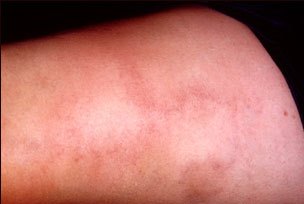Superficial thrombophlebitis
Contents
When to Contact a Medical Professional
Superficial thrombophlebitis is inflammation of a vein due to a blood clot in a vein located just below the skin's surface.
Causes
Superficial thrombophlebitis may occur after injury to the vein or the recent use of an intravenous (IV) line or catheter. If you have a high risk for this condition, you may develop one for no apparent reason.
Risks for superficial thrombophlebitis include:
- Chemical irritation of the area
- Disorders that involve increased blood clotting
- Infection
- Pregnancy
- Sitting or staying still for a prolonged period
- Use of birth control pills
- Varicose veins
Superficial thrombophlebitis may be associated with:
- Abdominal cancers (such as pancreatic cancer)
- Deep vein thrombosis
- Factor V Leiden
- Prothrombin gene mutation
- Thromboangiitis obliterans
Other rare disorders associated this condition include antithrombin III (AT-III), protein C and protein S deficiencies.
Symptoms
- Skin redness or inflammation along a vein that's just below the skin
- Warmth of tissue
- Tenderness or pain along a vein that's just below the skin -- pain is worse when pressure is applied
- Limb pain
- Hardening of a the vein (induration)

Shown here is erythema following the vascular pattern on a lower extremity. The superficial veins have become inflamed and dilated, causing the discoloration.
Exams and Tests
Your health care provider will diagnose superficial thrombophlebitis based mainly on the appearance of the affected area. Frequent checks of the pulse, blood pressure, temperature, skin condition, and blood flow may be needed.
The following tests can help confirm the condition:
- Doppler ultrasound
- Duplex ultrasound
- Venography
If there are signs of an infection, skin or blood cultures may be performed.
Treatment
The goals of treatment are to reduce pain and inflammation and prevent complications.
To reduce discomfort and swelling, support stockings and elevation of the affected extremity are recommended. A warm compress to the area may also be helpful.
A catheter or IV line should be removed if it is shown to have caused the thrombophlebitis.
Medications to treat superficial thrombophlebitis may include:
- Nonsteroidal anti-inflammatory drugs (NSAIDs) to reduce inflammation
- Painkillers
If deeper clots (deep vein thrombosis) are also present, your provider may prescribe medicines to thin your blood, called anticoagulates. Antibiotics are prescribed if you have an infection.
Surgical removal (phlebectomy), stripping, or sclerotherapy of the affected vein are occasionally needed to treat large varicose veins or to prevent further episodes of thrombophlebitis in high-risk patients.
Outlook (Prognosis)
Superficial thrombophlebitis is usually a short-term condition that does not cause complications. Symptoms generally go away in 1 to 2 weeks, but hardness of the vein may remain for much longer.
Possible Complications
Complications of superficial thrombophlebitis are rare. Possible problems may include the following:
- Infections (cellulitis)
- Deep vein thrombosis
When to Contact a Medical Professional
Call for an appointment with your doctor or nurse if you have symptoms of this condition.
Call your doctor or nurse if you have been diagnosed with superficial thrombophlebitis and your symptoms do not get better with treatment, or if your symptoms worsen.
Call if any new symptoms occur, such as a leg becoming pale, cold, or swollen, or if chills and fever develop.
Prevention
If you need to have an IV, the risk of superficial thrombophlebitis may be reduced by regularly changing the location of the IV and by immediately removal of the IV line if signs of inflammation develop.
Whenever possible, avoid keeping your legs and arm still for long periods of time. Move your legs often or take a stroll during long plane trips, car trips, and other situations in which you are sitting or lying down for long periods of time. Walking and staying active as soon as possible after surgery or during a long-term medical illness can also reduce your risk of thrombophlebitis.
Source: http://www.nlm.nih.gov/medlineplus/ency/article/000199.htm

